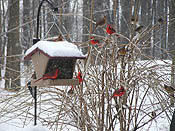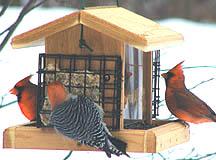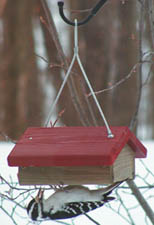Blog - General
Daves Bird Chatter January 2014
The Wild Bird Habitat Stores would like to extend a sincere thank you to all those individuals and families that are providing for our birds during these very cold periods we have been experiencing. It takes a lot of energy for birds to keep warm through the frigid nights out here on the Plains where wind-chills have plummeted to more than -30 degrees. The energy birds require to keep warm is only accomplished by spending the day -light hours foraging for food. And with shorter days during the winter months every opportunity spent foraging is crucial for their survival.

In an instant the majority of natural foods that birds rely can become buried under feet of snow. The freezing temperatures have frozen almost every last drop of water that is essential for the survival of all wildlife. The winter of 2013 / 2014 is bringing record cold weather to most of the continent making it very challenging for all our wild birds. Whereas most critters can find a burrow, den, or some form of shelter, our birds are left perched out in the open. They have been enduring some of the most extreme weather Mother Nature has to offer.
An extended period of research and observation by biologists during a harsh winter in upper Michigan studies shown that birds do not become reliant on bird feeders. That if the bird feeders were removed in mid-winter, the survival rate was equal to birds that never had access to feeders. In fact additional studies revealed that when birds had supplemental foods available at bird feeders throughout the winter months, their survival rates were higher. But of all the extremes nature throws at them it is loss of habitat from human activity that remains the number one cause of declining bird species and bird populations.
Birds have been around for millions of years. They are masters of survival. Many may perish during an extremely harsh winter, but the majority will persist and populations will recover. Birds are the most adaptive of all our wildlife. They have an intelligence that continues to amaze us, and the biologists that study them.
With the type of winter North America has been experiencing so far this year the Great Backyard Bird Count is more important than ever. This year the free count is from February 14 through the 17th, and we encourage everyone to participate. The data collected by “citizen scientists” provides valuable information on the movements of birds during winter. Birds are very dynamic and constantly on the move looking for new food resources as others become depleted. This is a good reason to keep observant, looking for unusual birds at your feeders. Many rare bird sightings are reported by backyard bird watchers. Those irruptive species, northern birds that drift south in winter looking for food, can create quite a bit of excitement when they appear.
When heavy snows and ice pack covers vast majorities of natural foods, backyard bird feeders can become a source of supplemental foods for our birds. This might be a good time to add another type of bird feeder to your existing backyard bird feeding program. Birds have specific feeding habits. Some will only feed on the ground. This is where ground bird feeders work well. It keeps seed off the ground and attracts Juncos, native sparrows, doves, and many others. Cardinals prefer a large perching area to forage on, such as a hopper bird feeder or a hanging platform feeder. The more types of bird feeders you have will attract a larger variety of birds. And just as important are the types of wild bird feeds offered in various feeders. This will also make a difference in the kinds of birds you attract. Consult our “Backyard Bird Feeding Basics” handout available at the Wild Bird Habitat Store, or “Backyard Bird Feeding 101” on-line at wildbirdhabitatstore.com. Or just ask our staff the next time you stop by any Wild Bird Habitat Store about the types of bird feeds available.
Another item that is essential for birds is grit; a fine gravel, coarse sand, or crushed rock to aid in digestion. Since birds do not have teeth to chew their food they need some form of grit to grind their food. The grit will sit in their crop and grind the seeds and other foods they consume. Coarse sand or fine gravel works well as does crushed egg shells. That is why you will often find Quail and Pheasant, as well as many song birds, near gravel roads in rural areas. At Wild Bird Habitat we carry a “granite grit” also call “chic-grit” that is specially ground for birds and is better than sand. The grit can be mixed in with the bird feed or placed out separate from the food in any accessible location. A little grit goes a long way.
Another key resource required for the survival of birds is water. Open fresh water can become rare during cold weather. Birds can fly in search of water. They  could eat snow. But both these activities lower their body temperatures use up valuable energy which must be replaced by foraging for additional foods to survive through the cold night. While birds may have multiple food sources to wander around to, fresh open water can be hard to find. We have a large assortment of heated bird baths, or bird bath heaters for your existing bird bath. There is still a lot of winter left when water will be scarce. Providing fresh unfrozen water during the winter months can attract more birds than just food alone.
could eat snow. But both these activities lower their body temperatures use up valuable energy which must be replaced by foraging for additional foods to survive through the cold night. While birds may have multiple food sources to wander around to, fresh open water can be hard to find. We have a large assortment of heated bird baths, or bird bath heaters for your existing bird bath. There is still a lot of winter left when water will be scarce. Providing fresh unfrozen water during the winter months can attract more birds than just food alone.
American Goldfinches are plentiful again this year, although we have yet to receive any reports about Pine Siskin arriving. They too were very numerous late last winter. Maybe the Siskins have found plenty of food resources to the north where they range. I had 30 to 40 Goldfinch arrive at my feeders just prior to Thanksgiving as temperatures dropped. Since then they have been a bit more sporadic. With the lack of heavy snow cover so far there is still plenty of natural foods available for them. Folks in the country did not see them flocking to thistle feeders until closer to Christmas.
The Goldfinches we have now are primarily the northern population as many of our resident Goldfinch drift south in the late fall. They will return the first of March, doubling the numbers of finch we enjoy. By then the males will begin to show their bright “canary” yellow breeding plumage. The northern birds will remain till early May when they will follow the dandelion bloom back to their nesting territory, leaving us with our summer resident Goldfinch populations.
As always, suet will be a prime target for woodpeckers. I am often asked if suet will get rancid and spoil. Raw suet, or beef fat, from the butcher can spoil, especially in warme r weather. It is best to use commercially rendered suet found in Wild Bird Habitat’s suet cakes, plugs, and balls. The beef fat is rendered by boiling. This kills any bacteria that could otherwise form. Some people have seen Carolina Wrens, nuthatches, Brown Creepers, and Chickadees at their suet feeders along with a variety of woodpeckers. All these birds will continue to enjoy the high energy of suet through the winter months. They will even consume more suet during the nesting season. This makes suet a great year round product.
r weather. It is best to use commercially rendered suet found in Wild Bird Habitat’s suet cakes, plugs, and balls. The beef fat is rendered by boiling. This kills any bacteria that could otherwise form. Some people have seen Carolina Wrens, nuthatches, Brown Creepers, and Chickadees at their suet feeders along with a variety of woodpeckers. All these birds will continue to enjoy the high energy of suet through the winter months. They will even consume more suet during the nesting season. This makes suet a great year round product.
There is a lot of winter weather left and at times it may be cold or inconvenient to go out to fill the bird feeders. But the benefits to birds and the joy they bring us make it all worthwhile when we are back inside our warm homes watching them. It’s a blessing we can help them in the short term. But as a people we need to assure their habitats are protected so future generations will be able to enjoy them the birds as well. We hope everyone has a great New Years of birding.
Yes, the winter of 2013 / 2014 will be a cold one to remember. We are only three weeks into winter and more cold and snow is predicted. Even if we have a late winter thaw, most the natural foods that were available for birds will have been consumed or destroyed. So keep your bird feeders filled, enjoy the Great Backyard Bird Count, and keep an eye out for any new birds showing up. Feel free to give us a call at Wild Bird Habitat and let us know. Backyard bird feeding! It’s beneficial for the birds, and enjoyable for us. Good bird watching to you all.
